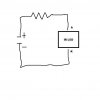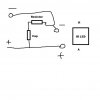Well the IC mixes the incoming signal (diode converts signal from AM, which strips the signal for voice or in the case of FM - sound) with the tuner signal coming from the tuner and then combines the 2 signals to go out of the 'output' and into another IC (not sure if the first one is 555 Timer or this one) which mixes the signal with the chosen level of sound from the amplifier and then comes out of that output.
this part i am having difficulty in. You said to convert the signal into light (hence the intensity would be provided by the previous circuits before it reaches this stage), i would need a photo-transistor thing? What ever is the component that converts sound signals into Light is what goes after the 555 Timer. Then that goes into the input of the Transmitter (which has the coils and caps tuned to the freq of Infra-red) and out through the LED.
I believe this is possible (the last part about the Infra- Red freq) as we use this Freq for remote controls and other uses.
Anyway, that is what the IC is for.
think if the AM/FM signal received by the receiver is amplified by a transistor or 2 then it should provide enough to send back through to the input of the 1st circuit with the battery source. Then the only problem would be to limit the amount coming into the circuit with a voltage regulator. But i'm wondering if the diode should come before the voltage regulator? i think it would explode, won't it? Still not sure. Further testing is required, which i will do.
Electro
you need to stop making these totally off base statements ... they truely make no sense at all
please Please PLEASE go read some books on radio transmission and reception
learn about how those things work, how modulation is added to them
Also read up on how to modulate a LED ( be it laser, visible, or IR types) with an audio signal and how you would receive that LED light and recover the audio
When you have done all that reading, then you will be able to come back and ask some good questions on the bits you didnt understand
if you dont do those things BEFORE coming back and asking some good questions, I will lock this thread OK ?
Dave









